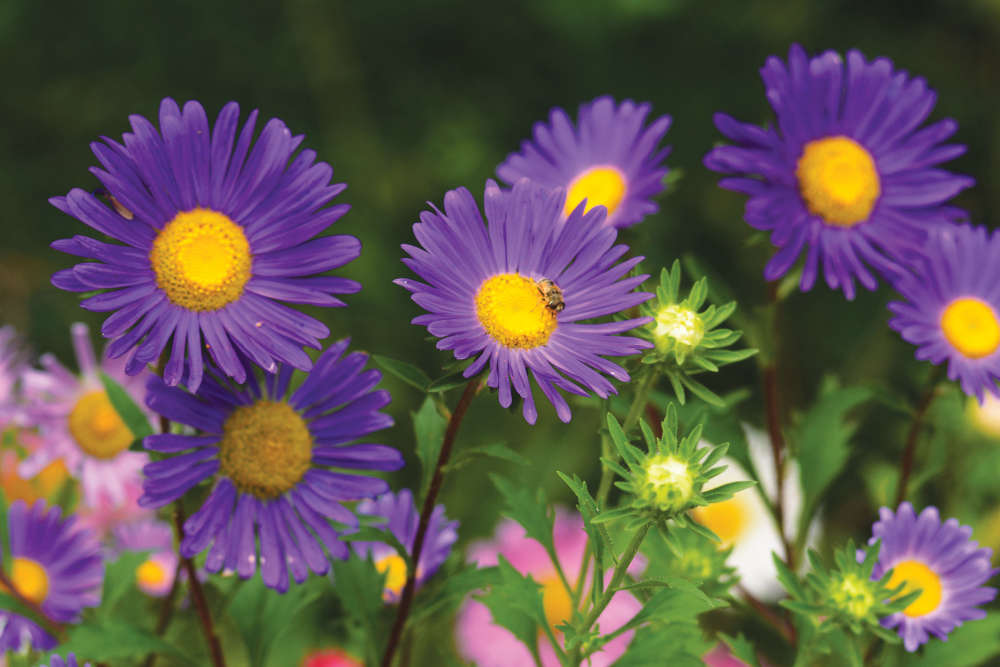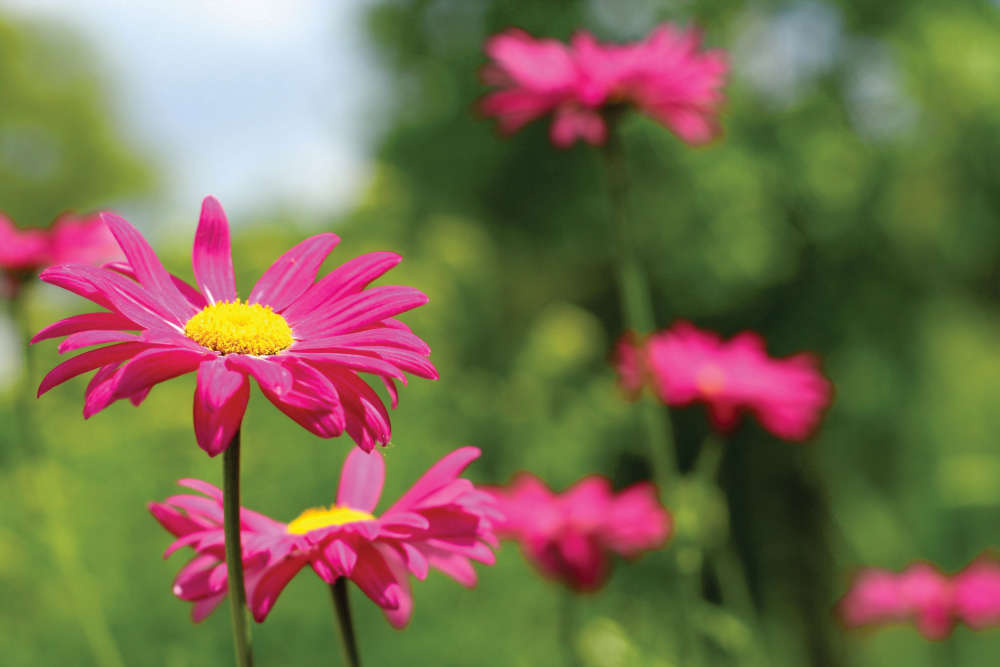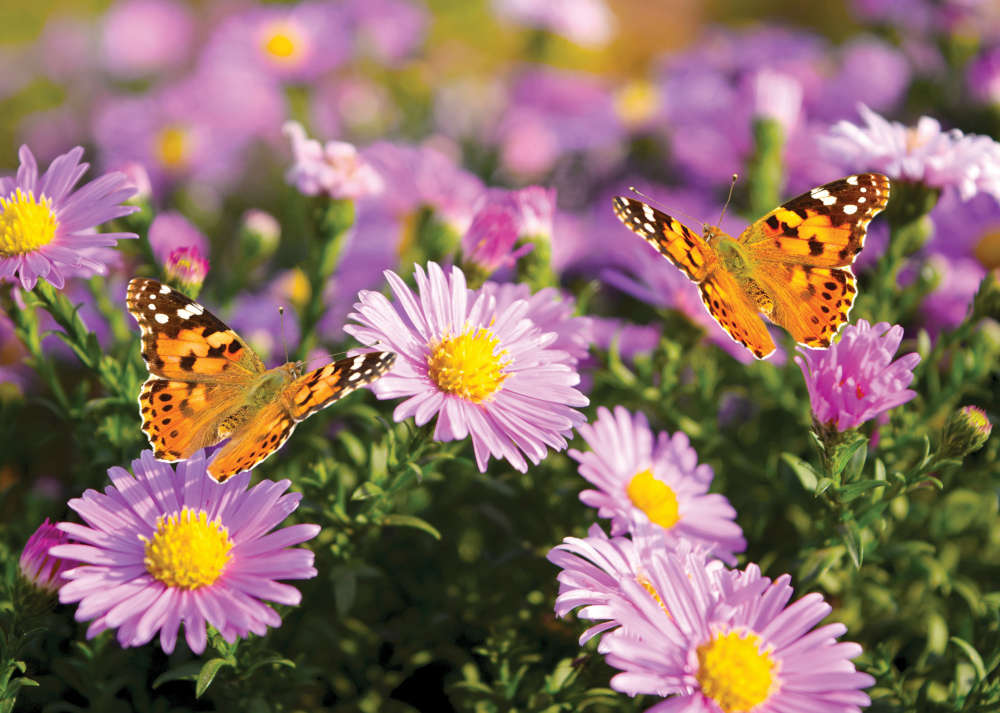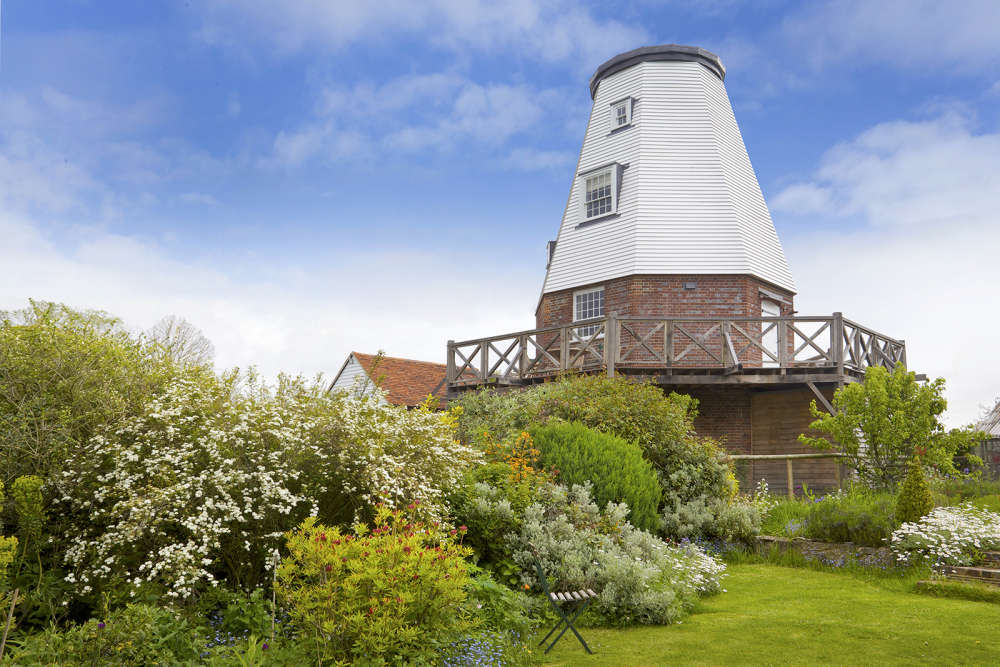
For a supernova finale in the autumn border, nothing outperforms asters, says Flo Whitaker. Even their name means ‘star’ – how perfect.
The aster family is a large one – although not as extensive as it once was. In a horticultural version of ‘Who Do You Think You Are?’ taxonomists, (scientists who study the ‘DNA’ of plants) have reclassified many. It appears some are more closely related to sunflowers or solidago, (Golden Rod). What does this scandalous family drama mean for the average gardener? Well, expect to find some familiar faces bearing unfamiliar name labels at the garden centre. Chances are, the ‘aster’ you’ve been referring to for donkey’s years, isn’t. However, their traditional, all-encompassing name, ‘Michaelmas Daisy’ will doubtless stick around forever and also indicates their peak blooming time, (29th September is the feast day of St Michael).

Perennial asters have a multi-branching habit with clouds of starry, daisy-like flowers, typically in shades of pinky-red, white and endless variations in the mauve/lilac/blue spectrum. Their trademark golden stamens are perfectly highlighted in autumn light –they’re also a valuable late-season food source for pollinating insects. From short-growers, (20-40cms) to lofty, back-of-the-border characters, reaching two metres or more, there is an obliging, easy-going aster to fill the gap. Asters are mostly trouble-free, although powdery mildew can affect them, but most modern varieties have been bred with mildew-resistance. Annual forms, (Callistephus), commonly known as ‘China/Chinese’ asters, make terrific cut flowers. The seed costs next to nothing and an April sowing will give you buckets of blooms from July onwards.

Whatever their botanical classifications, ‘asters’ require similar conditions; a sunny spot in moisture-retentive but well-drained soil. Most garden cultivars are descended from wild forms indigenous to American prairies, where winter temperatures may dip to -20⁰C, so an English winter holds no fear for them. What kills them is wet. Waterlogged soil quickly rots their roots – this can be particularly troublesome withsticky Wealden clay. Trial and error is the best bet. There’s always a spot in a border that’s a little more elevated/free draining than surrounding areas and some varieties will be more moisture-tolerant than others. A good way to keep a favourite variety going is to divide plants in March/April, just as the first shoots are emerging. Asters make tangled, fibrous mats of roots and are easy to lift and split. Plants naturally spread outwards as they grow and an established clump will often have a baldingpatch at its centre. Throw this part on the compost heap and use the newer, vigorous growth at the edges. Replant sections into the border, but save a few pieces forpotting into gritty compost. They can be grown on throughout summer and planted out in autumn. As an insurance against winter wet, overwinter a few pots in a cold frame to provide robust new plants the following spring.

 Home Style: Colourful New Life
Home Style: Colourful New Life
 Money Matters: Release Reality
Money Matters: Release Reality
 World Listening Day 2024: Learning to Listen to our Environment
World Listening Day 2024: Learning to Listen to our Environment
 Spotlight Events: What's On in July 2024
Spotlight Events: What's On in July 2024
 RSPCA Celebrates 200 Years
RSPCA Celebrates 200 Years
 Be Well, Move Happy: Learning a New Skill and Water Sports
Be Well, Move Happy: Learning a New Skill and Water Sports
 10 Ideas for a Screen-Free Summer
10 Ideas for a Screen-Free Summer
 Home Style: Bold Type
Home Style: Bold Type
 What to Watch in July 2024
What to Watch in July 2024
 The Exciting Appeal of the Beach Holiday
The Exciting Appeal of the Beach Holiday
 "I quite like to end up with a setlist that involves a catalogue of human misery..." Nish Kumar on his return to stand-up comedy
"I quite like to end up with a setlist that involves a catalogue of human misery..." Nish Kumar on his return to stand-up comedy
 Money Matters: The Revenue Generation
Money Matters: The Revenue Generation
 Home Style: A Better Way of Life
Home Style: A Better Way of Life
 Weddings: The Food of Love
Weddings: The Food of Love
 Vino, Vidi, Vici: The Vineyards, Breweries & Distilleries of Sussex
Vino, Vidi, Vici: The Vineyards, Breweries & Distilleries of Sussex
 Homes Extra: Digging a Design
Homes Extra: Digging a Design
 Listening to Nature: Meet the people behind the Ashdown Forest podcast
Listening to Nature: Meet the people behind the Ashdown Forest podcast
 Home Style: Tales from the Mill
Home Style: Tales from the Mill
 SPECIAL OFFER: General Admission Tickets To The Al Shira’aa Hickstead Derby Meeting
SPECIAL OFFER: General Admission Tickets To The Al Shira’aa Hickstead Derby Meeting
 A Gourmet Escape on the Eurostar: London to Amsterdam with Culinary Delights in Almere
A Gourmet Escape on the Eurostar: London to Amsterdam with Culinary Delights in Almere